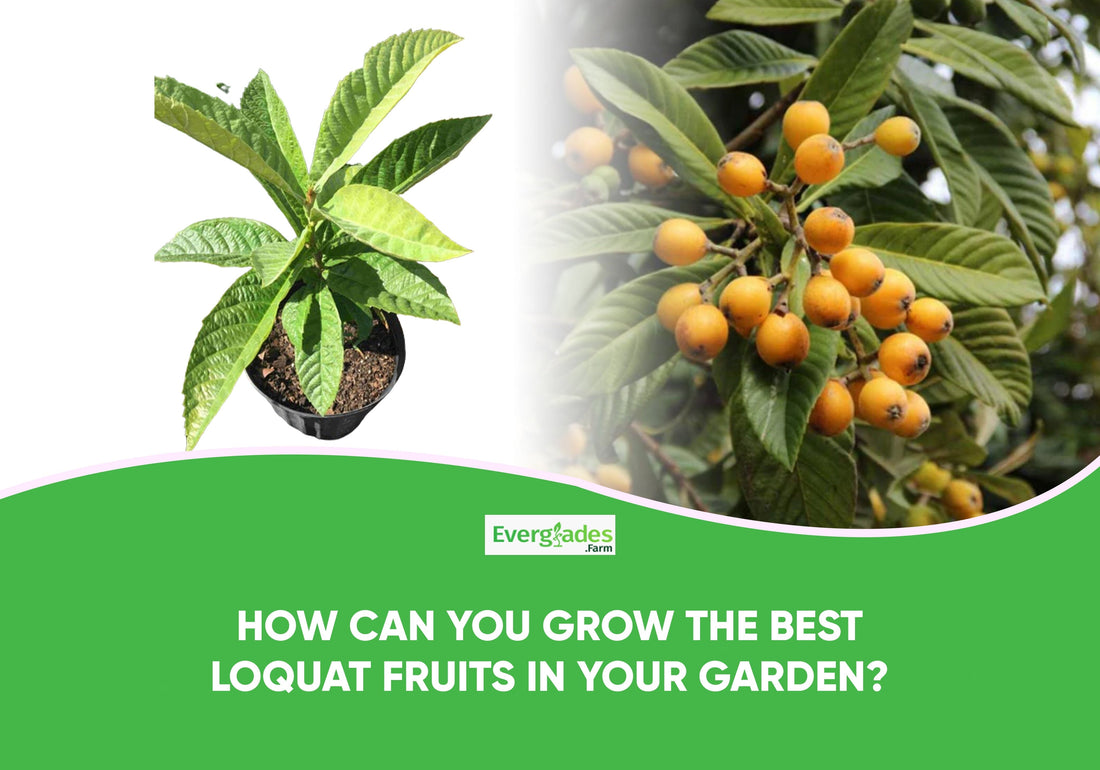
How Can You Grow the Best Loquat Fruits in Your Garden?
Share
Loquats are sweet and tangy fruits that make them perfect for jams or jellies. And they're filled with vitamins and minerals. No wonder more and more people now want to grow the best loquat fruits in your garden.
Luckily, loquats aren't too tricky to grow for amateur gardeners. Varieties like Gold Nugget and Early Red grow well in pots or on the ground. When planting loquat trees, give those trees plenty of space from other plants - they'll get 15-20 feet tall! Dig in some compost to help the roots establish. Water the young ones regularly so they grow strong.
As they mature, loquats do need some care. Feed with fertilizer in early spring when growth takes off. Water when rain's scarce so the loquat fruits plump up nicely.
Tips to grow the best loquat fruits in your garden
Here are some tips to help you grow thriving loquat plants:

Planting Location and Soil Preparation
If you want to grow the best loquat fruits in your garden, picking the right spot is crucial. Loquats thrive with full sunlight so their sweet loquat fruit can develop. Make sure to shelter them from wind, which is tough on young branches and affects fruiting.
When you are growing loquat trees prepare the soil by mixing 2-3 inches of rich compost throughout. You want that ground nice and nutrient-dense to feed those hungry roots! Test the pH - loquats prefer slightly acidic soils around 6-6.5 pH for best loquat tree growth.
Check drainage too as it is critical for healthy roots and loquat tree planting! Dig a hole 12” down and fill it with water. If it drains fully in a couple of hours, drainage works. If it puddles, amend the soil with compost to improve it before planting.
Planting Techniques
The best times for putting young loquat trees in the ground are early spring and late fall when they’re dormant. Give them lots of room, spacing your loquat orchard 20-25’ apart so they have space to reach that mature loquat tree size later on.
When transplanting from a nursery container, ensure the soil line on the stem matches the ground level. Backfill the hole with your enriched soil and water thoroughly to settle the roots after planting loquat trees. Consider staking them while young if in an exposed area.
Cover newly planted loquat tree trunks when frost comes so the cold doesn’t damage the wood. Monitor soil moisture regularly for the first couple of years and irrigate during dry spells for best establishment.
Watering and Mulching
Like all fruit trees, loquats need consistent moisture for vigorous growth and harvests! Water deeply once weekly during the growing season. Increase the frequency during hot, dry stretches.
Check soil moisture 4-6 inches down routinely. Apply 3-6 inches of organic mulch-like wood chips around the base. This retains moisture in the soil, reducing water needs. Mulch also curtails weeds robbing water and nutrition from your prized loquat.
Fertilization and Pruning
This is an important aspect of loquat plant care! Fertilize mature loquats annually in early spring with a balanced fertilizer when growth resumes. Use 1 pound per year of the tree’s age divided into smaller doses every 6-8 weeks thereafter through summer. This fuels plant energy for lush growth and a fabulous loquat fruit set!
Prune loquat branches strategically in late winter to remove dead wood, crossing branches causing rubs and center congestion limiting light and air. Pruning stimulates bountiful new growth and allows sunshine to reach developing loquat fruit for sweetness!
Pest and Disease Management
Though loquats are typically pest and disease-resilient, monitor for pests like aphids, scales, leafrollers, and fruit flies that can attack developing fruit, reducing the harvest. Get rid of aphids with a hard water spray. Apply organic insecticidal soap or Neem oil treatments for other bug problems. Avoid harsh chemicals dangerous for pollinators!
Check routinely for diseases like blights, leaf spots, or root fungus. Growing loquats in optimal conditions greatly boost tree health and immunity!
Conclusion
Want vibrant loquat plants for sale? Choose Everglades Farm for affordable, high-quality plants for sale! With over 50 years of growing and shipping tropical trees, we offer thousands of specimens for pick-up or super-fast shipping.
Everglades Farm promises healthy, vibrant plants ready for easy transport. Browse our full tropical inventory online including mango, banana, and more! Contact us!
FAQs
How do I start to grow a loquat tree in my garden?
To grow the best loquat fruits in your garden, start by choosing a sunny location with well-draining soil. Loquats prefer a subtropical climate but can tolerate a range of soil types.
What are the steps to grow a loquat tree from a seed?
For how to grow a loquat tree from a seed, follow similar steps: plant the seeds in fertile, well-draining soil; keep the soil consistently moist; and place the pot in a location that receives ample sunlight.
How long does a loquat tree take to produce fruit?
A loquat tree grown from seed typically takes about 6-8 years to bear fruit. For quicker fruiting, consider purchasing a grafted tree from a nursery.
Can loquat trees grow in cooler climates?
Loquat trees can tolerate cooler climates to some degree. However, they are sensitive to severe frosts. In regions with colder winters, it's advisable to grow loquats in pots that can be moved indoors during freezing temperatures.
Disclaimer- The information provided in this content is just for educational purposes and is written by a professional writer. Consult us to learn more about growing loquat fruits.

